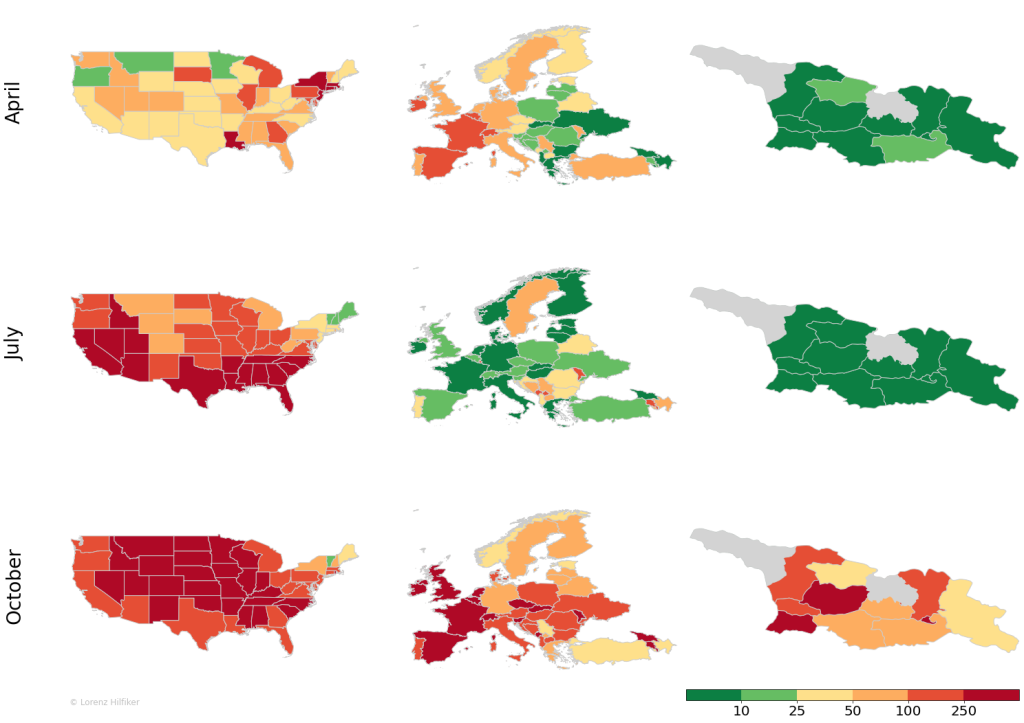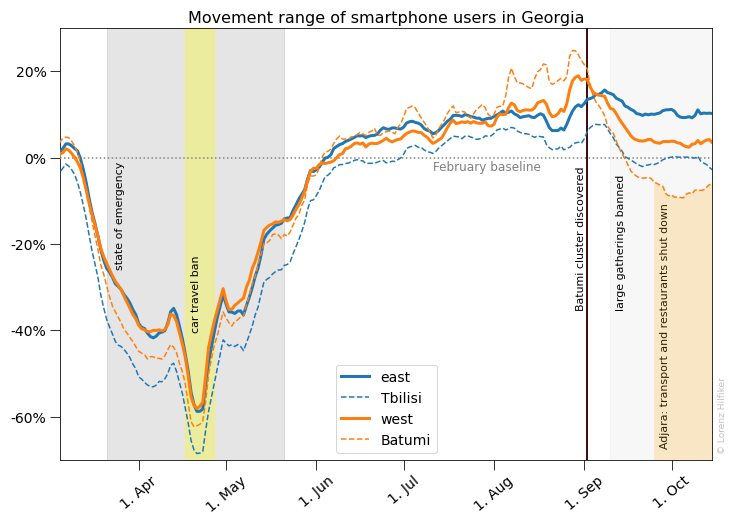
Within a single month, Georgia has gone from international COVID-19 model country to a high-risk zone. The government has adopted a more relaxed approach than in spring, relying on citizens’ cooperation rather than strict lockdowns. But mobility data indicates that the eastern half of the country has been slow to adapt to the return of the pandemic.
New confirmed cases reached a record 1595 on Thursday, while the death toll has reached 178. Already on Sunday, Department Head Marina Endeladze from the Tbilisi Infectious Disease Hospital called the situation ‘alarming’.
As of Wednesday, the average incidence per 100,000 inhabitants in two weeks stands at 308 cases for the whole country, 12 times the EU green zone limit. At the top of the regional incidence list is still Adjara, with 1002 cases per 100,000 inhabitants, followed by Imereti with 455, and Tbilisi with 349.
The surge in cases is happening against the background of a dramatic rise of coronavirus cases across Europe. Many cities and regions, for instance in Spain, France, Belgium, Poland, the Czech Republic, the UK, and the Netherlands, are again in partial or full lockdown.
As the incidence map shows, most of Europe is currently far outside the self-defined green zone. The Czech Republic leads the pack with a national 14-day incidence of 974 cases per 100,000 inhabitants.

The US has experienced one continuous long outbreak starting in spring in New York, sweeping the Southern States in summer and the Midwest in autumn. Western Europe (except for Sweden) has seen a wave in spring and now a wave in autumn. Eastern Europe and Georgia are experiencing their first large wave right now.
As always, it should be kept in mind that confirmed cases depend to some extent on the amount of testing. In particular, the incidence numbers in April are not directly comparable with those in July and October, since testing in the first half of April was severely limited in many countries, including the US. Had testing effort been at the level it is now, many areas in Europe and the US would appear one colour darker on the April map.
A more reliable metric than confirmed cases would be confirmed deaths, but such data is only retroactively published on a regional level by the Georgian health authorities.
Central and Eastern European countries have not been spared by this second wave. In March and April, most of them successfully averted the catastrophic outbreaks seen in some Western European countries by shutting the borders early and imposing strict lockdowns. Yet this time around, they are in the eye of the storm. Reports indicate that healthcare systems in many of these countries are now stretched to maximum capacity, running out of hospital beds, doctors, nurses, and tests.
The COVID histories of many Central and Eastern European countries sound remarkably similar: a strong resolve to suppress the pandemic at all cost in spring followed both by premature declarations of victory over the virus as well as growing public concern whether the economic cost of such an approach was worth the success.
Does Georgia fit into this pattern as well? According to surveys conducted by the Caucasus Research Resource Centres (CRRC) in May and June, a majority of participants continued to support the government‘s response but also expressed their belief that the economic burden of the pandemic was worse than the virus itself.
Perhaps most crucially, however, only a minority of respondents stated that they expect a second outbreak of COVID-19 in Georgia, casting the government‘s expectation management in a bad light.
Against the backdrop of these expectations, and with elections approaching on 31 October, the government was reluctant to clamp down hard when the pandemic hit again in September. Lockdowns were immediately ruled out, although the Prime Minister‘s latest remarks indicate he ultimately sees it in the hands of citizens to avoid such a scenario.
The government has thus far intervened with selective measures to slow the spread of the virus. Certain types of large gatherings have been banned nation-wide since 10 September, while restaurants, bars and other entertainment facilities are facing restricted opening hours in virus hotspots. Public transport in Adjara was suspended for three weeks, and various restrictions apply to the educational sector. But just how effective are those measures?
One possible indicator is citizens’ mobility as measured, for instance, by Facebook‘s granular movement range data.
Here, Facebook’s data scientists divide the Earth’s surface into tiles of roughly 500×500 metres and track the number of such squares that an individual smartphone appears in on any given day. The data is made public in an anonymised form and aggregated over all users by municipality.
Since the latest outbreak began at the end of August, the average movement range in Batumi has dropped by about 25% to below typical levels in winter. To a varying degree, a decrease in mobility can also be observed in most other places in western Georgia.

During August, mobility was more elevated in the west of the country, particularly in Batumi. Since the outbreak was discovered, mobility in the west has dropped considerably but changed little in the east.
Some of this effect could be due to the ban on large gatherings after 10 September, although the premature end of the tourism season and voluntary behavioural changes might have contributed as well.
In Batumi, the effect of public transport suspension and restrictions on restaurants and bars can be seen in the mobility data. Their combined impact on people‘s movement range seems to have been relatively minor. At the same time, there was a noticeable stagnation of new cases in Adjara around one week after the measures were implemented. That should, however, be taken with a grain of salt due to a change in testing policy after 2 October.
Contrary to the epicentres of the outbreak in the west, localities in eastern Georgia have only experienced a very small change in mobility in the wake of the gatherings ban.
In early September, one can even spot a temporary increase, perhaps associated with people returning from holidays in western Georgia. Unsurprisingly, in October the virus has spread at a faster rate in Tbilisi than in Batumi. It is too early to assess the effect of the latest restrictions imposed in the capital and in Imereti on 16 October.
In the meantime, worrying reports about bottlenecks in the healthcare system have been mounting. Hospital beds are becoming a scarce resource not only in Batumi, but also in Tbilisi, and testing is running at what seems to be the maximum sustainable capacity of around 10,000 PCR tests a day.
Presumably as a consequence, the National Centre for Disease Control announced a change of testing policy on 2 October according to which contacts of confirmed cases are only tested once they show symptoms. This likely resulted in a deceptive slump in case numbers during the following week.
PCR testing should be an area of major concern. The test positivity rate is now over 10%. To put this into context, the EU green zone requirement is 3%.
International experience in spring showed that countries with a positivity rate much above 10% tended to have uncontrolled outbreaks where contact tracing was virtually impossible.
Test positivity in most Central and Eastern European countries is currently between 13% and 25%, and contact tracing in several of them has already collapsed or never been fully implemented.
As another point of reference, the incidence rate in Switzerland is now at a similar level as in Georgia, and the test positivity rate has just surpassed 10%. Reports from many Swiss cantons indicate that the contact tracing system is severely strained and failing in some regions, with shortages both of staff as well as tests.
It is hard to assess from the information that has been published how well the contact tracing system is still working in Georgia at this point in time. However, if cases do not stop growing very soon, the system will inevitably reach a breaking point.
Despite the critical situation, the Georgian parliamentary elections are set to go ahead as planned on 31 October.
The government is performing a delicate balancing act. The governing Georgian Dream party is favoured to win the elections, and the pandemic is thought by many to play rather to their advantage. In this context, any additional coronavirus restrictions would risk alienating voters besides derailing the economy.
Yet, a failure to get the spread under control in the next few days could make another lockdown inevitable despite all the promises to the contrary. Georgia would not be the first country to backtrack on that.






